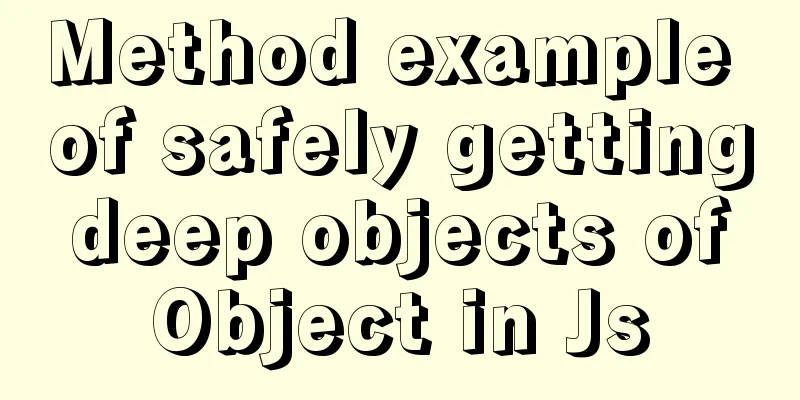Method example of safely getting deep objects of Object in Js

Preface Friends who work on the front end must have encountered situations where the data returned by the back end is nested in multiple layers. When I want to get the value of a deep object, I will do layer-by-layer non-empty checks to prevent errors, such as:
const obj = {
goods:
name: 'a',
tags: {
name: 'Fast',
id: 1,
tagType: {
name: 'Label'
}
}
}
}
When I need to get tagType.name, the judgment is like this
if (obj.goods !== null
&& obj.goods.tags !== null
&& obj.goods.tags.tagType !== null) {
}
If the attribute name is long, the code will be unreadable. Of course, ECMAScript 2020 has introduced ?. to solve this problem: let name = obj?.goods?.tags?.tageType?.name; But how to deal with browsers that are not compatible with ES2020? textStudents who have used lodash may know that there is a get method in lodash. The official website says: _.get(object, path, [defaultValue]) Get the value according to the path of the object. If the resolved value is undefined it will be replaced by defaultValue. parameter
example
var object = { 'a': [{ 'b': { 'c': 3 } }] };
_.get(object, 'a[0].b.c');
// => 3
_.get(object, ['a', '0', 'b', 'c']);
// => 3
_.get(object, 'abc', 'default');
// => 'default'
This solves the problem, but (I’m afraid there’s a “but”) What if I cannot use the lodash library due to various reasons such as project or company requirements? Now, let's see how lodash is implemented. Can't we just extract the code? Then we can happily move bricks again~~ Lodash implementation:
function get(object, path, defaultValue) {
const result = object == null ? undefined : baseGet(object, path)
return result === undefined ? defaultValue : result
}
What we do here is very simple. Let's look at the return first. If the object returns the default value, the core code is in baseGet, so let's look at the implementation of baseGet
function baseGet(object, path) {
//Convert the input string path into an array,
path = castPath(path, object)
let index = 0
const length = path.length
// Traverse the array to get each layer of objects while (object != null && index < length) {
object = object[toKey(path[index++])] // toKey method}
return (index && index == length) ? object : undefined
}
Here we use two functions: castPath (convert the input path to an array) and toKey (convert the real key) tokey function:
/** Used as references for various `Number` constants. */
const INFINITY = 1 / 0
/**
* Converts `value` to a string key if it's not a string or symbol.
*
* @private
* @param {*} value The value to inspect.
* @returns {string|symbol} Returns the key.
*/
function toKey(value) {
if (typeof value === 'string' || isSymbol(value)) {
return value
}
const result = `${value}`
return (result == '0' && (1 / value) == -INFINITY) ? '-0' : result
}
There are two main things done here.
The isSymbol function is also used here to determine whether it is a Symbol type. The code is not posted here. Students who are interested can check the lodash source code castPath function:
import isKey from './isKey.js'
import stringToPath from './stringToPath.js'
/**
* Casts `value` to a path array if it's not one.
*
* @private
* @param {*} value The value to inspect.
* @param {Object} [object] The object to query keys on.
* @returns {Array} Returns the cast property path array.
*/
function castPath(value, object) {
if (Array.isArray(value)) {
return value
}
return isKey(value, object) ? [value] : stringToPath(value)
}
castPath mainly converts the input path into an array to prepare for the subsequent traversal to obtain deep objects. isKey() and stringToPath() are used here. isKey is a relatively simple function to determine whether the current value is the key of an object. stringToPath mainly handles the case where the input path is a string, such as: 'abc[0].d' stringToPath function:
import memoizeCapped from './memoizeCapped.js'
const charCodeOfDot = '.'.charCodeAt(0)
const reEscapeChar = /\(\)?/g
const rePropName = RegExp(
// Match anything that isn't a dot or bracket.
'[^.[\]]+' + '|' +
// Or match property names within brackets.
'\[(?:' +
// Match a non-string expression.
'([^"'][^[]*)' + '|' +
// Or match strings (supports escaping characters).
'(["'])((?:(?!\2)[^\\]|\\.)*?)\2' +
')\]'+ '|' +
// Or match "" as the space between consecutive dots or empty brackets.
'(?=(?:\.|\[\])(?:\.|\[\]|$))'
, 'g')
/**
* Converts `string` to a property path array.
*
* @private
* @param {string} string The string to convert.
* @returns {Array} Returns the property path array.
*/
const stringToPath = memoizeCapped((string) => {
const result = []
if (string.charCodeAt(0) === charCodeOfDot) {
result.push('')
}
string.replace(rePropName, (match, expression, quote, subString) => {
let key = match
if (quote) {
key = subString.replace(reEscapeChar, '$1')
}
else if (expression) {
key = expression.trim()
}
result.push(key)
})
return result
})
Here we mainly exclude the . and [] in the path, parse the real key and add it to the array memoizeCapped function:
import memoize from '../memoize.js'
/** Used as the maximum memoize cache size. */
const MAX_MEMOIZE_SIZE = 500
/**
* A specialized version of `memoize` which clears the memoized function's
* cache when it exceeds `MAX_MEMOIZE_SIZE`.
*
* @private
* @param {Function} func The function to have its output memoized.
* @returns {Function} Returns the new memoized function.
*/
function memoizeCapped(func) {
const result = memoize(func, (key) => {
const { cache } = result
if (cache.size === MAX_MEMOIZE_SIZE) {
cache.clear()
}
return key
})
return result
}
export default memoizeCapped
Here is a limit on the cached key, clearing the cache when it reaches 500 memoize function:
function memoize(func, resolver) {
if (typeof func !== 'function' || (resolver != null && typeof resolver !== 'function')) {
throw new TypeError('Expected a function')
}
const memoized = function(...args) {
const key = resolver ? resolver.apply(this, args) : args[0]
const cache = memoized.cache
if (cache.has(key)) {
return cache.get(key)
}
const result = func.apply(this, args)
memoized.cache = cache.set(key, result) || cache
return result
}
memoized.cache = new (memoize.Cache || Map)
return memoized
}
memoize.Cache = Map
Actually, I don't quite understand the last two functions. If the input path is 'abc', can't we just convert it into an array? Why use closures for caching? I hope someone who understands this can give me an answer. Since the source code uses many functions and is in different files, I have simplified them. The complete code is as follows:
/**
* Gets the value at `path` of `object`. If the resolved value is
* `undefined`, the `defaultValue` is returned in its place.
* @example
* const object = { 'a': [{ 'b': { 'c': 3 } }] }
*
* get(object, 'a[0].b.c')
* // => 3
*
* get(object, ['a', '0', 'b', 'c'])
* // => 3
*
* get(object, 'abc', 'default')
* // => 'default'
*/
safeGet (object, path, defaultValue) {
let result
if (object != null) {
if (!Array.isArray(path)) {
const type = typeof path
if (type === 'number' || type === 'boolean' || path == null ||
/^\w*$/.test(path) || !(/.|[(?:[^[]]*|(["'])(?:(?!\1)[^\]|\.)*?\1)]/.test(path)) ||
(object != null && path in Object(object))) {
path = [path]
} else {
const result = []
if (path.charCodeAt(0) === '.'.charCodeAt(0)) {
result.push('')
}
const rePropName = RegExp(
// Match anything that isn't a dot or bracket.
'[^.[\]]+|\[(?:([^"'][^[]*)|(["'])((?:(?!\2)[^\\]|\\.)*?)\2)\]|(?=(?:\.|\[\])(?:\.|\[\]|$))'
, 'g')
path.replace(rePropName, (match, expression, quote, subString) => {
let key = match
if (quote) {
key = subString.replace(/\(\)?/g, '$1')
} else if (expression) {
key = expression.trim()
}
result.push(key)
})
path = result
}
}
let index = 0
const length = path.length
const toKey = (value) => {
if (typeof value === 'string') {
return value
}
const result = `${value}`
return (result === '0' && (1 / value) === -(1 / 0)) ? '-0' : result
}
while (object != null && index < length) {
object = object[toKey(path[index++])]
}
result = (index && index === length) ? object : undefined
}
return result === undefined ? defaultValue : result
}
The code is borrowed from lodash References:
SummarizeThis is the end of this article about safely getting deep-level objects of Object in Js. For more relevant content about getting deep-level objects of Object in Js, please search previous articles on 123WORDPRESS.COM or continue to browse the following related articles. I hope you will support 123WORDPRESS.COM in the future! You may also be interested in:
|
<<: MySQL uses mysqldump+binlog to completely restore the deleted database principle analysis
>>: How to use nginx to build a static resource server
Recommend
Summary of several principles that should be followed in HTML page output
1. DOCTYPE is indispensable. The browser determin...
Example of using mycat to implement MySQL database read-write separation
What is MyCAT A completely open source large data...
About the pitfalls of implementing specified encoding in MySQL
Written in front Environment: MySQL 5.7+, MySQL d...
Mini Program to Implement Slider Effect
This article example shares the specific code for...
Design a simple HTML login interface using CSS style
login.html part: <!DOCTYPE html> <html l...
vue-cli configuration uses Vuex's full process record
Table of contents Preface Installation and Usage ...
The perfect solution for MYSQL5.7.24 installation without data directory and my-default.ini and service failure to start
MySQL official website download address: https://...
Detailed explanation of incompatible changes of components in vue3
Table of contents Functional Components How to wr...
JS interview question: Can forEach jump out of the loop?
When I was asked this question, I was ignorant an...
A brief discussion on the built-in traversal methods of JS arrays and their differences
Table of contents forEach() (ES6) method map() (E...
Sample code for implementing form validation with pure CSS
In our daily business, form validation is a very ...
How to obtain a permanent free SSL certificate from Let's Encrypt in Docker
1. Cause The official cerbot is too annoying. It ...
Linux Basic Tutorial: Special Permissions SUID, SGID and SBIT
Preface For file or directory permissions in Linu...
How to solve the error when connecting to MySQL in Linux: Access denied for user 'root'@'localhost'(using password: YES)
Preface Recently connected to mysql /usr/local/my...
Implement a simple data response system
Table of contents 1. Dep 2. Understand obverser 3...









